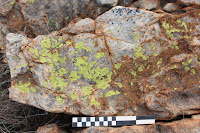Neoplasmic
tumors are areas of localized tissue growth where cellular
proliferation occurs without the oversight of the bodies growth
control mechanisms. These are split into two categories, malign
growths which are often fatal, and which are the second highest cause
of death among modern human populations (after coronary disease), and
benign growths, which are not typically lethal but which often cause
chronic long-term illnesses. Cancers are often considered to be
modern diseases, caused by poor lifestyles choices which make us more
prone to the genetic damage that causes them, but they are known in
both the fossil and archaeological record, albeit at extremely low
levels, and probably occurred at higher levels than we are aware of,
as only cancers affecting hard tissues such as bone are likely to be
preserved.
In a
paper published in the South African Journal of Science on 28 July
2016, Patrick Randolph-Quinney of the School of Anatomical Sciences
and Evolutionary Studies Institute at the University of theWitwatersrand, describe a benign tumour from a 1.98-million-year-old
Australopithicine from Malapa Cave at the Cradle of Humankind WorldHeritage Site in Guateng Province, South Africa.
The
tumour is located in the sixth thoracic vertebra of an individual
known as MH1 (Malapa Hominin 1), a juvenile male with a development
roughly equivalent of a 12-13-year-old Modern Human, which is the
specimen from which the species Australopithecus sediba (thought
to bebe a likely candidate for the species ancestral to the genus
Homo) was described. This
specimen is one of two specimens of Australopithecus
sediba from Malapa Cave, which,
along with a number of other Hominins, are thought to have fallen
into the vertical cave and died, rather than used it as a dwelling,
as with the other caves at the Cradle of Humankind site.
The tumour measures approximately 6.7 by 5.9 mm and penetrates the
bone from the right surface of the bone. The right portion of the
vertebrae appears thickened relative to the left, apparently
indicating remodelling of the bone in reaction to the tumour. The
lesson formed by the tumour widens beneath the entrance hole, then
narrows deeper into the bone, deviating slightly to the right. It
does not penetrate the vertebral canal, but the position of and bone
modification caused by the tumour may have affected the articulation
of both the spine and the right shoulder, and could quite possibly
have been a source of acute or chronic pain and even muscle spasming.
Sixth thoracic vertebra of juvenile Australopithecus sediba
(Malapa Hominin 1). Partially transparent image volume with the
segmented boundaries of the lesion rendered solid pink. Volume data
derived from phase-contrast X-ray synchrotron microtomography. (a)
Left lateral view, (b) superior view, (c) right lateral view. Paul
Tafforeau in Randolph-Quinney et al. (2016).
Given the thickening of the bone around the lesson, Randolph-Quinney
et al. rule out the possibility of this being a post-mortem
artefact. The absence of inflammation around the the tumour is also
indicative; as such inflammation would be expected with cancers such
as brucellosis, nonspecific osteitis, haematogenous osteomyelitis or
treponemal osteitis, and the morphology of the tumour is inconsistent
with a diagnosis of vertebral osteomyelitis. There is no sign of the
deformation and regrowth that might be associated with a trauma such
as a healed fracture, and the youth of the victim makes it highly
unlikely that the lesson was caused by osteosarcoma, chondrosarcoma
or Ewing’s sarcoma.
The possible causes of the lesson are therefore thought to be osteoid
osteoma, osteoblastoma, giant cell tumour and aneurysmal bone cyst,
of which an osteoid osteoma or osteoblastoma are thought to be the
most likely. Of these the pathology most resembles an osteoid
osteoma, though these are rare in the bones of the spine, being most
common in the lower limb bones. Randolph-Quinney et al. therefore
conclude that an osteoid osteoma os the most likely cause of the
observed pathology, but that an osteoblastoma cannot be ruled out.
See also...
 Evidence of Lichen growth on the bones of Homo naledi. In 2013 scientists in South Africa described the discovery of a
remarkable new Hominin species in the Dinaledi Cave System in Gauteng
State, South Africa (part of the Maropeng Cradle of Humankind...
Evidence of Lichen growth on the bones of Homo naledi. In 2013 scientists in South Africa described the discovery of a
remarkable new Hominin species in the Dinaledi Cave System in Gauteng
State, South Africa (part of the Maropeng Cradle of Humankind... Malignant Osteosarcoma in a 1.7 million-year-old Hominin Metatarsal from Swartkrans Cave, South Africa. Malignant
Cancers are the biggest singe killer of...
Malignant Osteosarcoma in a 1.7 million-year-old Hominin Metatarsal from Swartkrans Cave, South Africa. Malignant
Cancers are the biggest singe killer of... Hominin rib from Sterkfontein Caves. Sterkfontein Caves is a palaeoarchaological excavation site about 40 km
to the northwest of Johannesburg in Gauteng State, South Africa, which
forms part of the Maropeng Cradle of Humankind World Heritage Site
has previously produced a large volume of early Hominin material
(fossils of...
Hominin rib from Sterkfontein Caves. Sterkfontein Caves is a palaeoarchaological excavation site about 40 km
to the northwest of Johannesburg in Gauteng State, South Africa, which
forms part of the Maropeng Cradle of Humankind World Heritage Site
has previously produced a large volume of early Hominin material
(fossils of...
Follow Sciency Thoughts on Facebook.

